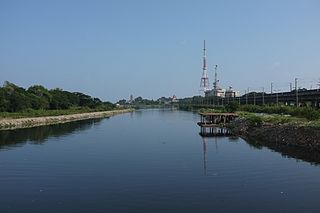
Chennai, formerly known as Madras, is the capital city of Tamil Nadu, the southernmost state of India. It is the state's primate city both in area and population and is located on the Coromandel Coast of the Bay of Bengal. According to the 2011 Indian census, Chennai is the sixth-most populous city in India and forms the fourth-most populous urban agglomeration. Incorporated in 1866, the Greater Chennai Corporation is the oldest municipal corporation of India and the second oldest in the world after London.
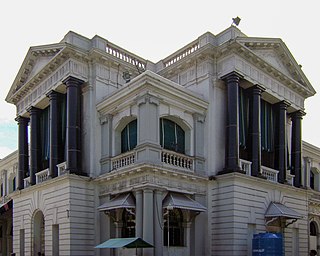
Fort St. George is a fortress at the coastal city of Chennai, India. Founded in 1639, it was the first English fortress in India. The construction of the fort provided the impetus for further settlements and trading activity, in what was originally an uninhabited land. Thus, it is a feasible contention to say that the city evolved around the fortress. The fort currently houses the Tamil Nadu legislative assembly and other official buildings.

Francis Napier, 10th Lord Napier and 1st Baron Ettrick, was a Scottish polyglot, diplomat and colonial administrator. He served as the British Minister to the United States from 1857 to 1859, Netherlands from 1859 to 1860, Russia from 1861 to 1864, Prussia from 1864 to 1866 and as the Governor of Madras from 1866 to 1872. He also acted as the Governor-General of India from February to May 1872.
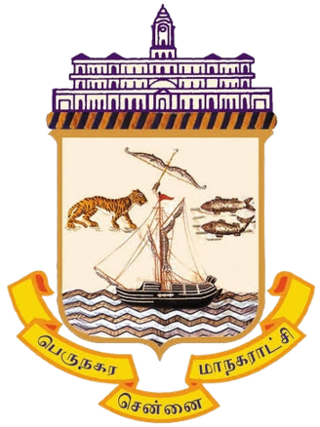
Greater Chennai Corporation (GCC) is a local government for the City of Chennai in the Chennai Metropolitan Area of Tamil Nadu, India. Inaugurated on 29 September 1688, under a royal charter issued by King James II of England on 30 December 1687 as the Corporation of Madras, it is the oldest municipal body of the Commonwealth of Nations outside Great Britain. It is the largest municipal corporation in Tamil Nadu with an area of 426 km2. It is headed by a mayor, who presides over 200 councillors, each of whom represents one of the 200 wards of the city. It is the second oldest corporation in the world after the City of London. The city limits, which had been expanded several times over the years, is currently coterminous with the Chennai district. It is one of the four municipal corporations located within the Chennai Metropolitan Area, the other three being the Tambaram Corporation, Avadi City Municipal Corporation and Kanchipuram Municipal Corporation.

Thyagaraya Nagar, commonly known as T. Nagar, and historically known as East Mambalam, is a very affluent commercial and residential neighbourhood in Chennai, Tamil Nadu, India. It is surrounded by Nungambakkam in the North, Teynampet in the East, Nandanam in the South-East, C.I.T. Nagar in the South and West Mambalam and Kodambakkam in the West. The stretch between Duraiswamy Road and T. Nagar Bus Stand has some of the costliest real estates in Chennai. It was constructed between 1923 and 1925 by the Madras Presidency government of the Raja of Panagal as a part of town planning activities initiated according to the Madras Town Planning Act of 1920. The town was named after P. Thyagaraya Chetty. The streets, parks and localities in the new neighbourhood were named after important officials in the provincial government.

Tambaram is a city located within the Chennai Metropolitan Area in the Indian State of Tamil Nadu. The city is governed by Tambaram City Municipal Corporation.
Egmore is a neighbourhood of Chennai, India. Situated on the northern banks of the Coovum River, Egmore is an important residential area as well as a commercial and transportation hub. The Egmore Railway Station was the main terminus of the Madras and Southern Mahratta Railway and later, the metre gauge section of the Southern division of the Indian Railways. It continues to be an important railway junction. The Government Museum, Chennai is also situated in Egmore. Other important institutions based in Egmore include the Government Women and Children's Hospital, the Tamil Nadu State Archives and the Tamil Nadu Archaeology Department. The Wesley Church, Egmore is the oldest church of the region.
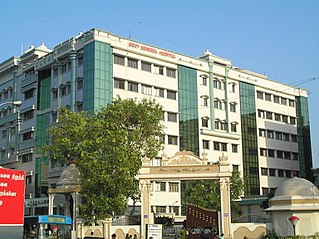
Rajiv Gandhi Government General Hospital is a major state-owned hospital situated in Chennai, India. The hospital is funded and managed by the state government of Tamil Nadu. Founded in 1664 by the British East India Company, it is the first modern hospital in India. In the 19th century, the Madras Medical College joined it. As of 2018, the hospital receives an average of 12,000 outpatients every day.

George Town is a neighbourhood in Chennai, Tamil Nadu, India. It is near the Fort Saint George, Chennai. It is also known as Muthialpet and Parry's corner. It is an historical area of Chennai city from where its expansion began in the 1640s. It extends from the Bay of Bengal in the east to Park town on the west. The Fort St. George is on the south, to Royapuram in the north. The Fort St. George houses the Tamil Nadu Legislative Assembly and the Secretariat. The High court of Tamil Nadu at Chennai, Dr. Ambedkar Law College, Stanley Medical College and Hospital are located here.
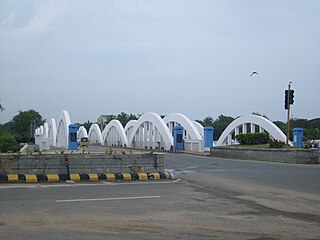
Napier Bridge is a bridge in Chennai, India, built over the Coovum River, connecting Fort St. George with the Marina beach. It is also one of the historic structures and landmark of the city.

Chepauk Palace was the official residence of the Nawab of Arcot from 1768 to 1855. It is situated in the neighbourhood of Chepauk in Chennai, India and is constructed in the Indo-Saracenic style of architecture.

The Triumph of Labour, also known as the Labour statue, is a statue at the Marina Beach, Chennai, India. Erected at the northern end of the beach at the Anna Square opposite University of Madras, it is an important landmark of Chennai. The statue shows four men toiling to move a rock, depicting the hard work of the labouring class. It was sculpted by Debi Prasad Roy Chowdhury. The statue is the earliest one to be erected on the beach and is installed close to the site where the country's first commemoration of May Day was held. The statue was installed on the eve of the Republic Day in 1959, as part of the Kamaraj government's drive to beautify the beach. The statue remains the focal point of May Day celebrations in the city.
Chintadripet is a locality in Chennai, in India. Located on the southern banks of the Cooum River, it is a residential-cum-commercial area surrounded by Chepauk, Island Grounds, Pudupet, Egmore, Anna Salai and Chennai Central
Nageswara Rao Park is a 4-acre (1.6-hectare) park located on Luz Corner in Mylapore, Chennai, India. The park, with a separate play area for children, is kept open to the public from 5 a.m. to 8 p.m. and is a popular place for morning walks among the locals. The park also hosts music kutcheris and civic forums, on the weekends all year round. The park has a badminton court. The park is maintained by Sundaram Finance.
This is a timeline of major events in the history of Chennai.
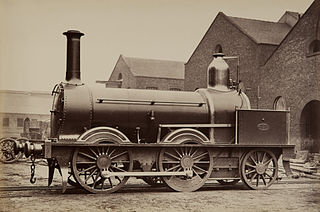
Madras Railway was one of the railway companies operating rail services in British India.
Events in the year 1867 in India.
Madras Tramway was the former organization that was responsible for building the first tramways in India in the city of Madras. It was existent in the city for about 67 years starting from the end of the 19th century.








